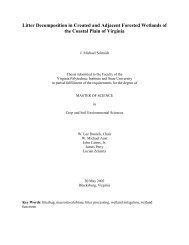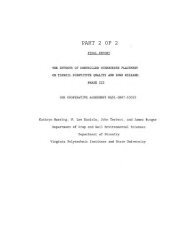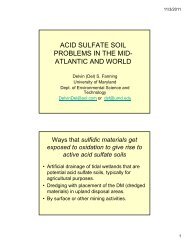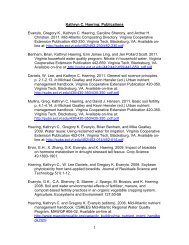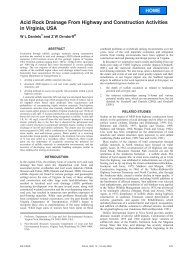Remediation of PAH-Contaminated Soils and Sediments: A ...
Remediation of PAH-Contaminated Soils and Sediments: A ...
Remediation of PAH-Contaminated Soils and Sediments: A ...
Create successful ePaper yourself
Turn your PDF publications into a flip-book with our unique Google optimized e-Paper software.
Ozone treatment<br />
Ozone treatment is carried out with injection <strong>of</strong> gaseous or aqueous ozone (Choi<br />
et al., 2001). Ozone can transform <strong>PAH</strong>s into a polar, more soluble, <strong>and</strong> thus<br />
more biodegradable oxygenated intermediate. Oxidation <strong>of</strong> organic matter by<br />
ozone also can release some <strong>of</strong> the sequestered <strong>PAH</strong>s making them more<br />
available to biodegradation (Goi <strong>and</strong> Trapido, 2004; O’Mahony et al., 2006; Nam<br />
<strong>and</strong> Kukor, 2000). The presence <strong>of</strong> metal oxides can catalyze the formation <strong>of</strong><br />
hydroxyl radicals which are more aggressive oxidant than ozone.<br />
Ozone treatment can be made more effective when it is used as a part <strong>of</strong> an<br />
integrated strategy such as extraction before ozonation, or ozonation followed by<br />
biodegradation. The extraction step improves the oxidation efficiency <strong>of</strong> ozone<br />
due to the increase <strong>of</strong> accessibility to oxidation. Organic solvents with low toxicity<br />
<strong>and</strong> the ability to dissolve high amount <strong>of</strong> ozone are good choices for extractants<br />
since they can be used as a carrier to introduce ozone in the system (Rivas et<br />
al., 2004).<br />
Zeng <strong>and</strong> Hong (2002) used ozonation to treat sediments contaminated by coal<br />
tar <strong>and</strong> reported that ozonation modified the inorganic <strong>and</strong> organic content <strong>of</strong> the<br />
sediments so as to improve the subsequent biodegradability. Kulik et al. (2006)<br />
found that ozonation removed more HWM <strong>PAH</strong> while biodegradation removed<br />
more LMW <strong>PAH</strong>. Stehr et al. (2001) reported that ozonation had a negative<br />
effect on the subsequent biodegradation <strong>of</strong> benzo[a]pyrene <strong>and</strong> phenanthrene.<br />
Disadvantages <strong>of</strong> ozonation include the production <strong>of</strong> intermediates which can be<br />
more toxic than the parent compound. Ozonation can also destroy the<br />
indigenous microbial degraders. The destruction <strong>of</strong> the indigenous microbial<br />
community, however, might improve the chance <strong>of</strong> successfully inoculating the<br />
system later with specific bacteria that have high degradation potential (Rivas,<br />
2006).<br />
Fenton’s reagents<br />
Fenton’s reagents use peroxide at different concentrations (3 to 35%) along with<br />
ferrous iron (Fe II) as a catalyst to oxidize organic chemicals (Flotron et al.,<br />
2005). Peroxide (H2O2) decomposes into highly reactive nonspecific hydroxyl<br />
radicals with the help <strong>of</strong> ferrous iron. Optimum pH for the reaction is 3-5, since if<br />
the pH is too high, iron will precipitate as iron oxides <strong>and</strong> will decompose<br />
peroxide. The iron can be artificially added with the peroxide, but if the soil has<br />
high enough iron oxide content (goethite, hematite or magnetite); there is no<br />
need to add iron (Watts et al., 2002; Kawahara et al., 1995). The decomposition<br />
process <strong>of</strong> peroxide is exothermic. The heat generated might enhance the<br />
62



